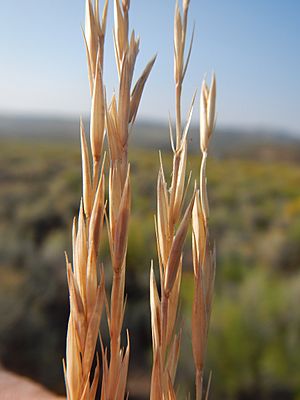Leymus salina facts for kids
Quick facts for kids Leymus salina |
|
|---|---|
 |
|
| Conservation status | |
| Scientific classification | |
| Genus: |
Leymus
|
| Species: |
salina
|
| Synonyms | |
|
|
Leymus salina is a type of grass known by several names, including Salina wildrye and Salina Pass wild rye. This plant grows naturally in the western United States. It got its name from Salina Pass, Utah, which is where it was first discovered.
Contents
About Salina Wildrye
Salina wildrye is a perennial grass. This means it lives for more than two years. It often grows in thick bunches, with stems reaching up to 1.4 meters (about 4.5 feet) tall. Sometimes, it has special underground stems called rhizomes. These rhizomes help the plant spread and grow new shoots.
Leaves and Flowers
Most of the leaves of Salina wildrye grow near the bottom of its stems. The plant's flowers grow in a special cluster called an inflorescence. This inflorescence looks like a spike. Along this spike, you'll find small groups of flowers called spikelets. Each spikelet usually has one or two flowers, but it can have up to six.
Different Types of Salina Wildrye
There are three main types, or subspecies, of Leymus salina:
- Leymus salina subsp. salina
- Leymus salina subsp. mojavensis – also called Mojave wildrye
- Leymus salina subsp. salmonis – also called salmon wildrye
Where Salina Wildrye Grows
This grass can be found in many different places across the western United States. It often grows in pinyon-juniper forests and Gambel oak woodlands. In Colorado, Salina wildrye often grows alongside other plants. These include Wyoming big sagebrush, shadscale, and Gardner's saltbush. It's an important part of these plant communities.


